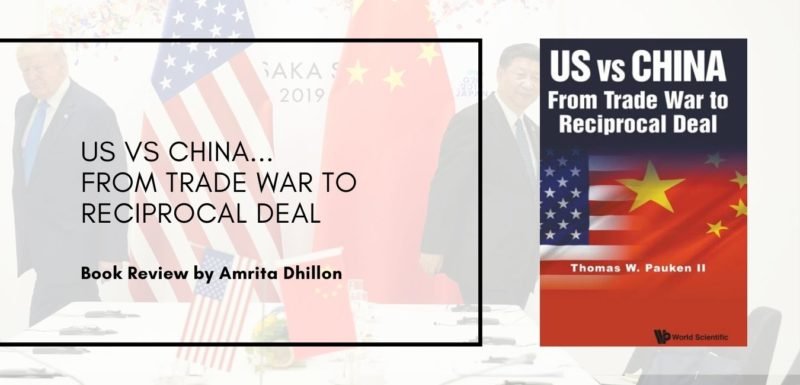Book Review: US vs China… From Trade War to Reciprocal Deal

It was only 2016 when the world started paying close attention to one of the biggest geoeconomic shift in decades. The two giants, US and China started confronting each other on the commercial ground, and the impact apparently witnessed by the world. It has been three years and this geoeconomic game is not slowing down at all.
We all have been reading about US-China trade war but in most of the cases we learn about the Western narratives, the reason could be many, like linguistic barriers or a growing feeling of mistrust for China.
Thomas W. Pauken II’s book, US vs China… From Trade War to Reciprocal Deal takes you in an alternate world, which leaves you with a lot of questions at the end of the book and many answers which will make you think twice and google about it.
The author takes you to a journey where he explains the economic reformation era of Deng. His words try to change a common perception on Maoism as the Chinese identity, he talks about the reforms, which made a third world country like China advancing to match its tune with rest of the world in terms of economic gain and what challenges are in front of Chinese policymakers.
This book gives you a perspective which can’t be dubbed and refuted by Western critics as propaganda. There are very few books from the Eastern half of the world, which equally praise and criticise the government policies in order to present all aspects in front of readers.
This book, very systematically explains the background, reasons for the Trade War, the globalist approach, and the common ground where both China and the United States can meet and resolve the trade disputes.
Tom’s book impressively puts the challenges of Chinese economic transformation, especially Deng’s delicate political balancing act, and silent globalist motives, which laid the bedrock of Chinese transformation. The author stresses on Deng Era reformation which in other words can be referred to alexander’s cutting off the Gordion’s knot.
This book explores the wide range of options for talk and dialogue on the trade deal between the United States and China in the ‘America First era’.
Also Read: Is America Still First?
American Dream vs Chinese Dream
The author tries to draw parallel lines between the American and the Chinese Dream. One of the points which crossover is the optimism, he explains, how with a bolstering economy the optimism is also soaring high among the young Chinese citizens.
The author explains how Chinese aspire to adapt to the modern-day era and maintain closer relations with other sovereign nations. He highlights the basic difference between the two dreams from two different worlds, the Chinese dream first and foremost represents Chinese patriotism and culture, but this is not same in the case of the American dreams. (As suggested by the author).
Trump’s ‘Unprecedented’ Diplomacy

This book talks about Trump and ‘his doctrine’ of making diplomatic pressure on opponents for negotiation. It highlights the use of social media platforms like Twitter and its use by President Trump as one of his Diplomatic tool.
Other than a trade war, the U.S. President has also waged a war of words, he frequently calls out China for the IP theft and copyright violations, to which author explains the Chinese belief in ‘saving face’ and not to be shamed in public. The books refer to one of the speeches by Trump in 2016, where Trump claimed, China was ‘raping’ Americans on trade issues. This was dubbed very much offensive by the Chinese, giving them a shockwave, and the ‘rapist tag’ inflicted a deep wound in their hearts which could be hard for them to forgive.
The books discuss how understanding the sensitivity of the matter, leaders from both sides show caution while speaking in public. And stop this never-ending tariff game, to which Trump was very much optimistic about a clear victory, instead, he met with retaliatory tariffs from the Chinese side.
Globalist vs anti-globalist approach
The United States is believed to be a pioneer of globalist approach, however, in this ‘America first’ thought, the US is taking an anti-globalist turn, whereas, China is flexing its muscles and reaching out to all the left, right and centre. China is doing all possible efforts to achieve Made in China 2025 Plan, which gives a message that the Chinese stood prepared to adapt to new technologies in the age of automation in the manufacturing sector.
This book also highlights the changing perception of socialism and capitalism with Chinese characteristics. It explains China’s model of governance, and clear all the clusters surrounding China’s image of a full-blown communist country still carrying the legacy of Mao.
Concluding Remarks
If you’re looking for the other side of the coin, you can go ahead with this book. This book will not disappoint you, rather it gives you another realm of thoughts, where you’ll go through a journey witnessing China’s rise on the global stage, its infrastructural growth, regional integration, challenges and too much hope to see a trade deal between the United States and China.
Probably, this book will give an idea to many scholars to think about the possible scenarios of US-China trade deal.


















